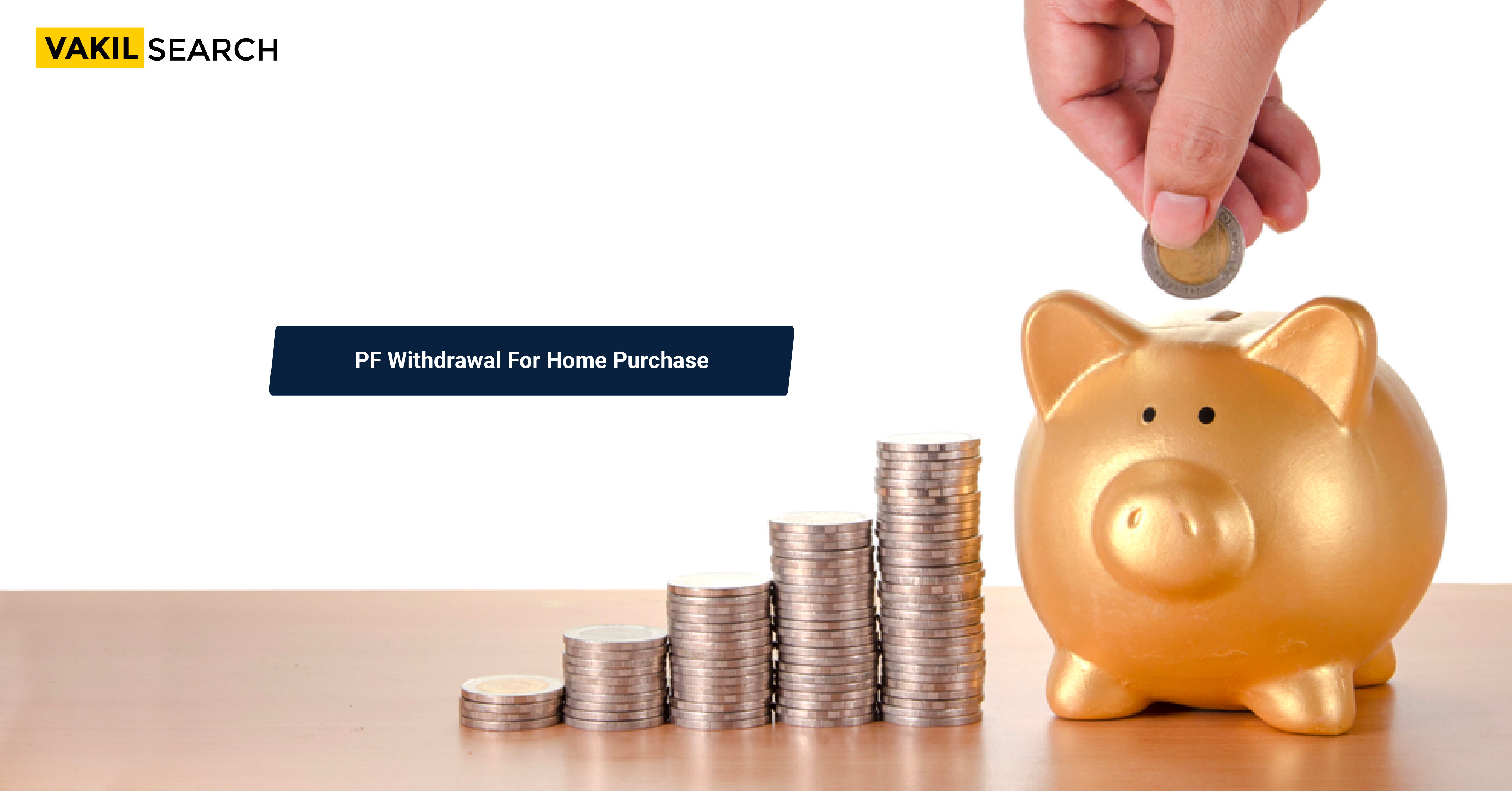This article explains the PF withdrawal process for home purchases, including eligibility, rules, and documentation. It also covers tax implications.
For many salaried individuals, the Provident Fund (PF) serves as a financial safety net, an egg nest for retirement. However, there are occasions when you can tap into your PF for personal reasons, such as purchasing a home. In this comprehensive guide, we’ll explore the PF Withdrawal for Home Purchase and rules for home purchases, empowering you to make informed financial decisions.
Additionally, we’ll touch upon the tax implications and introduce you to Vakilsearch’s ITR (Income Tax Return) services, specially designed to assist you with your financial journey.
Understanding Provident Fund (PF)
Before diving into the details of PF withdrawal for home purchases, let’s establish a clear understanding of the Provident Fund:
The Provident Fund is a retirement scheme managed by the Employees’ Provident Fund Organisation (EPFO). Both employees and employers contribute a fixed amount each month to the employee’s PF account. Over time, these contributions accumulate into a lump sum, typically withdrawn upon retirement. However, there are provisions that allow employees to withdraw their PF for specific purposes, including purchasing a house.
PF Withdrawal Rules for Home Purchase
To utilize your PF for home purchases, you need to adhere to certain rules:
Minimum Contribution Duration: You can only withdraw PF for home purchases if you have been contributing to your PF account for a minimum of 5 years.
Withdrawal Amount: You are eligible to withdraw an amount equal to 36 months’ basic salary plus Dearness Allowance (DA) or the required amount, whichever is lower.
Property Type: PF withdrawal for a home purchase is applicable only for the purchase of a new property, not for resale properties.
The PF Withdrawal Process for Home Purchase
Here’s a step-by-step guide to withdrawing your PF for purchasing a home:
-
Eligibility Check:
- Ensure that you meet the eligibility criteria for PF withdrawal for home purchase, including the minimum contribution duration.
-
Gather Documentation:
- Collect the necessary documents for PF withdrawal, including forms such as Form 31, 10D, 10C, and 19.
- A canceled cheque from your desired bank account for fund disbursement.
- You will also need your latest bank statement, two revenue stamps, proof of address (e.g., Passport, Aadhaar Card, Electricity bill), and proof of identity (e.g., PAN card, Aadhaar card)
- Form Submission and Verification:
- Complete the required forms with accurate details.
- Submit the forms along with the supporting documents. You can do this through the EPF portal or with your employer, though it may involve a lengthy process.
- The submitted application will undergo verification and processing.
- Fund Disbursement:
- Once your application is approved, the designated amount will be credited directly to your bank account for your home purchase.
PF Offline Withdrawal Process
You can initiate the process of PF withdrawal offline in India by submitting a Composite Claim Form at the nearest EPFO (Employees’ Provident Fund Organization) office. There are two types of Composite Claim Forms available for this purpose: Aadhar and Non-Aadhaar.
-
Composite Claim Form (Aadhar Form):
– This form is used when your Aadhar card and bank details are linked with your UAN (Universal Account Number) account.
– In such cases, you won’t require any attestation from your employer.
– Ensure that your Aadhar details and bank account information are correctly linked to your UAN account.
-
Composite Claim Form (Non-Aadhar Form):
– If your Aadhar card and bank details are not linked with your UAN account, you will need to use the Non-Aadhar form.
– This form must be attested by your employer before submission.
– Make sure to get the necessary attestation from your employer as per the instructions provided.
Once you have completed the relevant Composite Claim Form, you should visit the EPFO office in person to submit it. This offline process is recommended if you don’t remember your UAN number or have misplaced it.
Ensure that you have all the required documents and information before visiting the EPFO office to facilitate a smooth withdrawal process.
PF Home Loan Withdrawals: Upper Limit
Besides using your PF for home purchases, the EPFO permits several other utilizations:
PF Withdrawal for Home Construction: If you have completed at least 5 years of service, you can withdraw up to 90% of your PF for constructing a house.
PF Withdrawal for Home Renovations: You can withdraw an amount equivalent to 12 times your basic monthly salary plus DA for home renovations.
PF Withdrawal for Ready-to-move-in Home Loan Repayment: You can withdraw an amount equal to 36 months’ basic salary plus DA to repay your home loan.
The Takeaway
Utilizing your Provident Fund for a home purchase is a significant financial decision. While it can help you realize your homeownership dreams, it’s essential to understand the rules, eligibility criteria, and tax implications.
As you navigate this process, consider seeking guidance from experts, such as those from Vakilsearch, to ensure your financial well-being. Remember that your Provident Fund plays a crucial role in securing your retirement. So Withdraw from it judiciously and only when it is absolutely necessary.
FAQs (Frequently Asked Questions)
Is PF withdrawal for home purchase taxable?
Yes, if the withdrawn PF amount exceeds Rs. 2.5 lakh, it is considered income from other sources and is taxable. However if the employee has rendered five or more years of continuous service, PF withdrawal is not taxable.
How many times can I withdraw from my PF account for home purchases?
You are allowed to withdraw from your PF account for home purchases once during your employment tenure.

